The Durian is not an ordinary fruit, not for the Asians, in which countries it is the king of fruits, nor for Westerners, who regard it with mistrust. Even its shape is strange: like a large green hedgehog, covered with thick, conical spines, which give it its Malayan name “duri”, taken from the scientific term, “Durio”, and by the common names in different languages, including Lao. Another characteristic of the fruit is evoked by its scientific name: its smell; “zibethinus” comes from the Italian “zibetto”, meaning “civet”, an animal smelling very strongly of musk.
This extraordinary fruit, with its origin on the islands of Sumatra and Borneo, grows on a very tall tree of about 40 metres in height, pyramidal in shape and leaves of a green-bronze. The Durian Tree flowers once or twice a year, according to the species and the location. The cream-colored flowers do not open until the afternoon, and at night, they are fertilized by bats. The blossoms have a smell of sour milk which invades the area. Its huge fruits – some of which measure 30 cm in diameter – fall loudly when ripe; their thick skin, like a grey-beige shell, is marked with depressions indicating where it shouldl be opened. The inside is comprised of five, sometimes six, compartments, each one of them containing from one to six large, shiny nuts, surrounded by a compact yellowish, creamy pulp. A Durian Tree bears fruit after its fourth or fifth year and, at full maturity, can produce between 200-800 fruit per year.
This smooth pulp, eaten either with one’s fingers or with a spoon, has a very strong smell and a taste which is difficult to analyse, it stays in one’s mouth for a long time, it resembles no other taste, and has inspired numerous observers. Thus, Monseigneur Pallegoix, who spent about thirty years in Siam, in the 19th century, pointed out that “the smell of the Durian is extremely strong and off-putting for the newly-arrived Europeans, who liken it to the smell of excrement, yet, however, the peculiar fact is that when one actually eats the fruit, the smell becomes a delicious perfume.” A Malayan proverb says it differently: “It smells of hell, but it has the taste of paradise”. Nevertheless, the durian is a fragile fruit which decomposes rapidly (within 48 hours) after having been picked and its flesh sours if one takes too long to eat it after opening.
The characteristics of the Durian are such that it is little grown outside its original zone, despite its large economic value. Conservation techniques in salt are traditional in Malaysia, but, above all, the horticulturists are working to make varieties less fragile and the Thais re-masters in that regard. Not content to have focused on a variety considered the best, called mon thong or “pillow of gold”, they are working towards a less prickly variety, which would make it easier to peel, and a variety without smell, which would make it more freely transportable (currently it is, in effect, forbidden in public transportation and in hotels). It is also important to know that Thailand is the world’s number one producer of the Durian, with an annual production of 950,000 tons.
In southern Laos, where some plantation attempts were made, mak thoulien is imported from Vietnam and Thailand, but the fruit remains a luxury product sold by specialized merchants. The pulp is eaten as is, like a mango, with sticky rice; sometimes one also eats the grains, roasted.
Traditional medicine, which puts this fruit in substances of astringent flavour, recommends the decoction of the peel to treat wounds; its flesh might have tonic properties, and the leaves and roots might be able to fight fever.
Le durian n’est un fruit ordinaire ni pour les Asiatiques chez qui il est le roi des fruits, ni pour les Occidentaux qui le considèrent avec méfiance. Sa forme même est étrange: gros hérisson vert bardé de fortes épines coniques qui lui ont valu son nom malais « duri » repris par la nomenclature scientifique « Durio » et par les noms vulgaires en différentes langues y compris le Lao. Une autre caractéristique du fruit est évoquée par son nom scientifique son odeur; « zibethinus » vient de l’italien « zibetto » signifiant « civette », animal à la très forte odeur de musc.
Ce fruit exceptionnel, originaire des îles de Sumatra et Bornéo, pousse sur un grand arbre d’une quarantaine de mètres de haut, à l’allure pyramidale et au feuillage vert bronze. Le durian fleurit une ou deux fois l’an selon l’espèce et le lieu. Les fleurs de couleur crème ne s’ouvrent que l’après-midi et sont fécondées la nuit par des chauves-souris. Cette floraison s’accompagne d’une odeur de lait aigre qui envahit l’espace. Ses gros fruits – certains font jusqu’à 30cm de diamètre – tombent lourdement à maturité; leur épaisse enveloppe, comme une carapace gris beige, se marque alors de dépressions selon lesquelles il faudra l’ouvrir. L’intérieur comprend cinq, parfois six compartiments, chacun d’eux abritant de un à six gros noyaux luisants, entourés d’une pulpe jaunâtre et crémeuse très compacte. Un arbre porte des fruits dès sa quatrième ou cinquième année et, en pleine maturité, peut fournir entre 200 et 800 fruits par an.
Cette pulpe onctueuse que l’on mange telle que, aux doigts ou à la cuillère, a une odeur très forte et une saveur difficilement analysable, longue en bouche, qui ne ressemble à aucune autre et qui a inspiré de nombreux observateurs. Ainsi, Monseigneur Pallegoix qui passa une trentaine d’années au Siam au XIX siècle remarque que « l’odeur du Durion est extrêmement forte et rebutante pour les Européens nouvellement arrivés qui la comparent à celle des excréments, et cependant (chose singulière), quand on mange ce fruit cette odeur se change en parfum délicieux ». Un proverbe malais le dit autrement : « Il sent l’enfer mais il a le goût du paradis ». Cependant le durian est un fuit fragile qui se décompose rapidement (en 48h) après avoir été cueilli et sa chair aigrit si l’on tarde trop à la manger après ouverture.
Les particularités du durian font qu’il est peu cultivé hors de sa zone d’origine et ce malgré sa grande valeur économique. Des techniques de conservation dans le sel sont traditionnelles en Malaisie, mais surtout, les horticulteurs travaillent à fabriquer des cultivars moins fragiles et, en la matière, les Thaïlandais sont passés maîtres. Non contents d’avoir mis au point une variété considérée comme la meilleure appelée mon thong ou « oreiller d’or », ils travaillent à une variété sans piquant qui rendrait l’emballage plus facile, et à une variété sans odeur qui en rendrait le transport plus libre (celui-ci est en effet interdit dans les transports en commune et les hôtels). Il faut savoir aussi que la Thaïlande est le premier producteur mondial de durion avec une production de 950 000 tonnes par an.
Au Laos où quelques tentatives de plantation sont faites dans le Sud, on importe mak thoulièn du Vietnam et de Thaïlande, mais le fruit reste un produit de luxe vendu par des marchands spécialisés. On en consomme la pulpe telle quelle ou, comme on le fait de la mangue, avec du riz gluant; parfois aussi on en mange les graines rôties au feu.
La médecine traditionnelle qui range ce fruit dans les substances à saveur astringente en recommande la décoction d’écorce pour soigner les plaies; sa pulpe aurait des propriétés toniques et les feuilles et racines permettraient de lutter contre la fièvre.
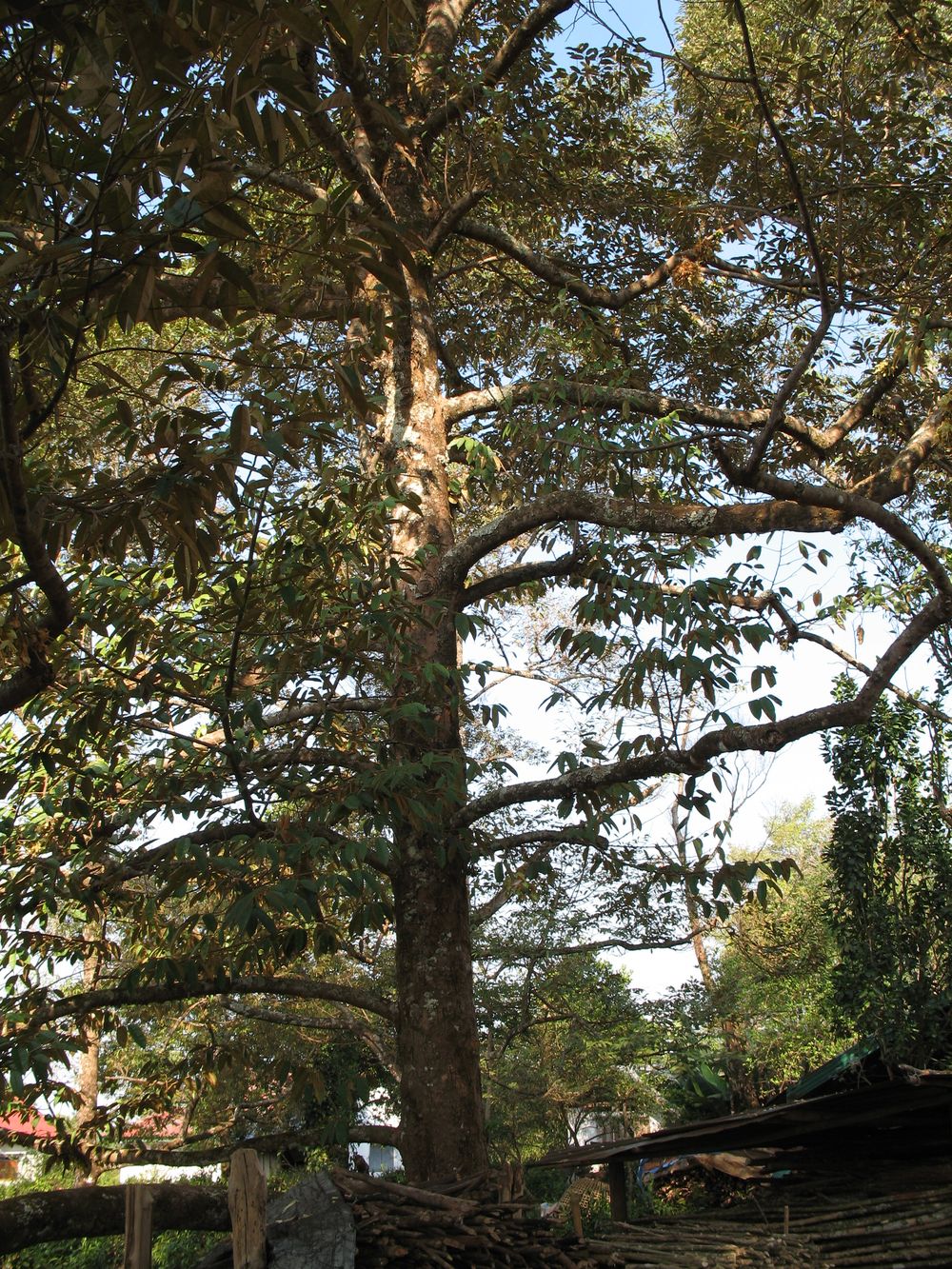
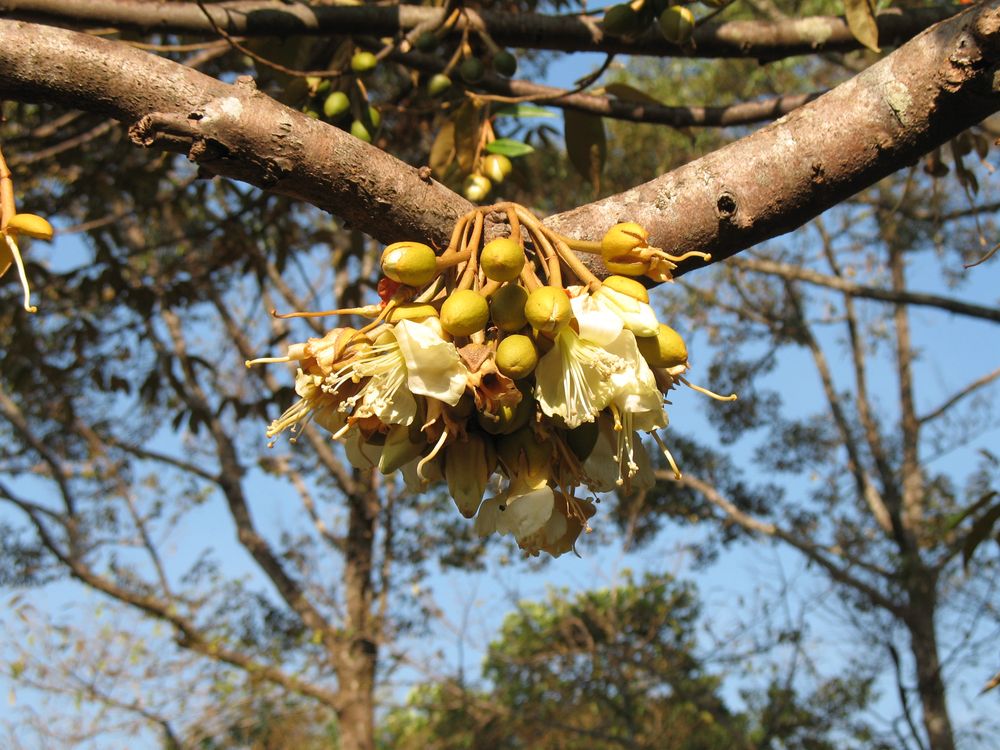
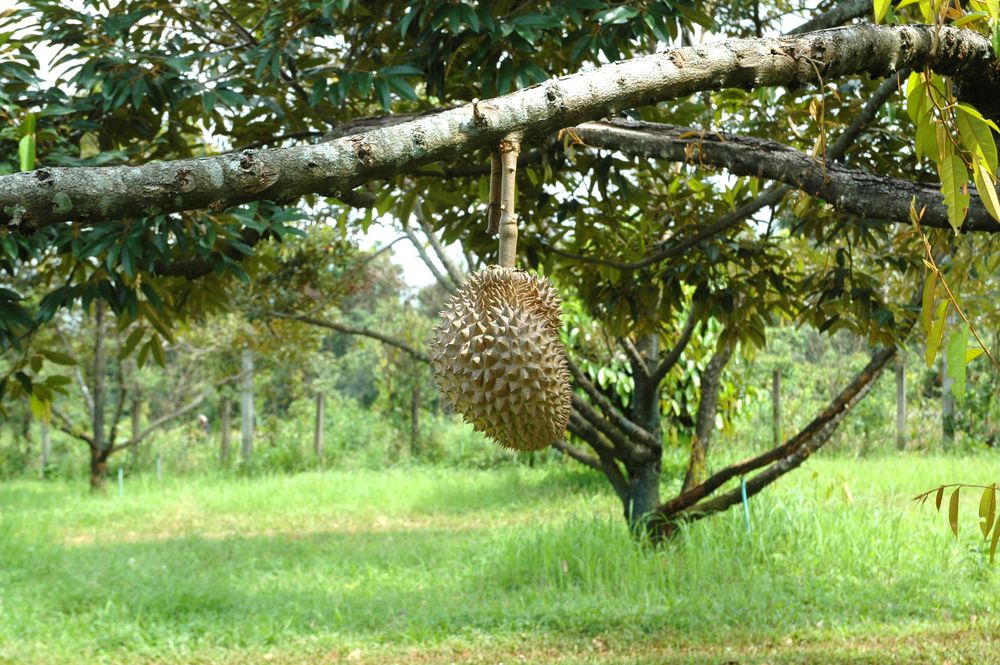
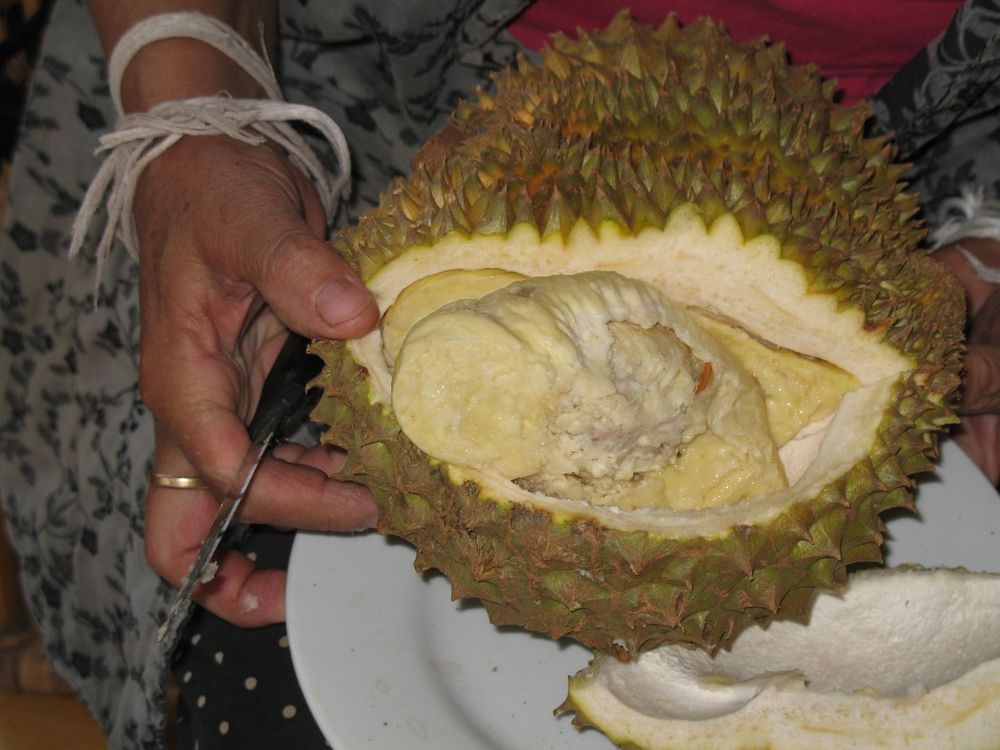
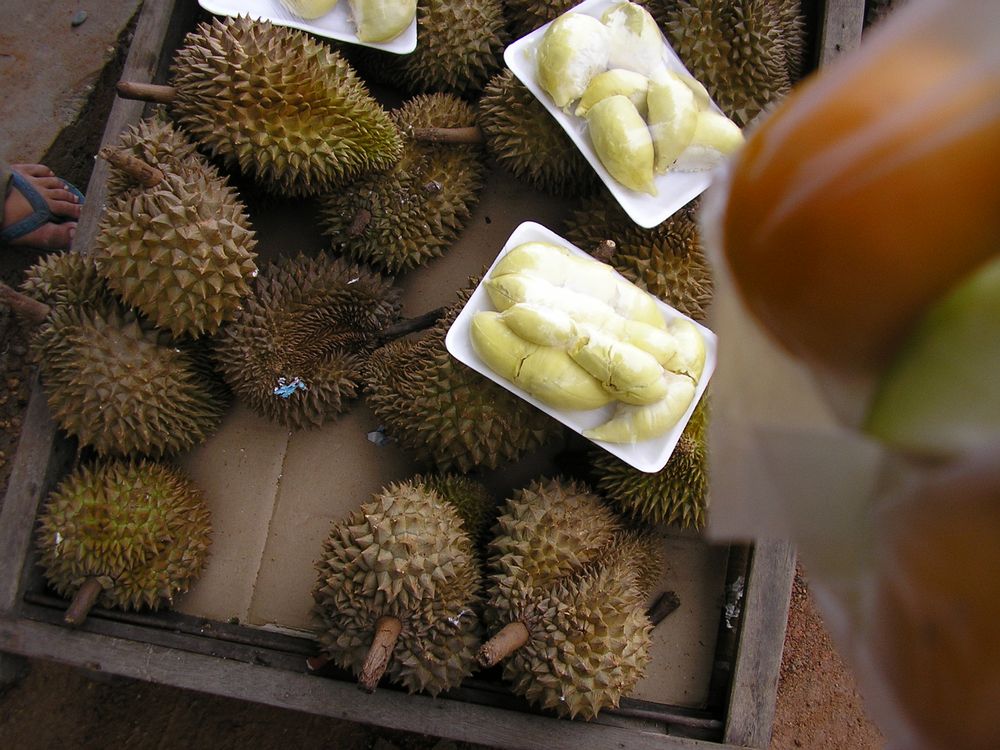
The Durian is not an ordinary fruit, not for the Asians, in which countries it is the king of fruits, nor for Westerners, who regard it with mistrust. Even its shape is strange: like a large green hedgehog, covered with thick, conical spines, which give it its Malayan name “duri”, taken from the scientific term, “Durio”, and by the common names in different languages, including Lao. Another characteristic of the fruit is evoked by its scientific name: its smell; “zibethinus” comes from the Italian “zibetto”, meaning “civet”, an animal smelling very strongly of musk.
This extraordinary fruit, with its origin on the islands of Sumatra and Borneo, grows on a very tall tree of about 40 metres in height, pyramidal in shape and leaves of a green-bronze. The Durian Tree flowers once or twice a year, according to the species and the location. The cream-colored flowers do not open until the afternoon, and at night, they are fertilized by bats. The blossoms have a smell of sour milk which invades the area. Its huge fruits – some of which measure 30 cm in diameter – fall loudly when ripe; their thick skin, like a grey-beige shell, is marked with depressions indicating where it shouldl be opened. The inside is comprised of five, sometimes six, compartments, each one of them containing from one to six large, shiny nuts, surrounded by a compact yellowish, creamy pulp. A Durian Tree bears fruit after its fourth or fifth year and, at full maturity, can produce between 200-800 fruit per year.
This smooth pulp, eaten either with one’s fingers or with a spoon, has a very strong smell and a taste which is difficult to analyse, it stays in one’s mouth for a long time, it resembles no other taste, and has inspired numerous observers. Thus, Monseigneur Pallegoix, who spent about thirty years in Siam, in the 19th century, pointed out that “the smell of the Durian is extremely strong and off-putting for the newly-arrived Europeans, who liken it to the smell of excrement, yet, however, the peculiar fact is that when one actually eats the fruit, the smell becomes a delicious perfume.” A Malayan proverb says it differently: “It smells of hell, but it has the taste of paradise”. Nevertheless, the durian is a fragile fruit which decomposes rapidly (within 48 hours) after having been picked and its flesh sours if one takes too long to eat it after opening.
The characteristics of the Durian are such that it is little grown outside its original zone, despite its large economic value. Conservation techniques in salt are traditional in Malaysia, but, above all, the horticulturists are working to make varieties less fragile and the Thais re-masters in that regard. Not content to have focused on a variety considered the best, called mon thong or “pillow of gold”, they are working towards a less prickly variety, which would make it easier to peel, and a variety without smell, which would make it more freely transportable (currently it is, in effect, forbidden in public transportation and in hotels). It is also important to know that Thailand is the world’s number one producer of the Durian, with an annual production of 950,000 tons.
In southern Laos, where some plantation attempts were made, mak thoulien is imported from Vietnam and Thailand, but the fruit remains a luxury product sold by specialized merchants. The pulp is eaten as is, like a mango, with sticky rice; sometimes one also eats the grains, roasted.
Traditional medicine, which puts this fruit in substances of astringent flavour, recommends the decoction of the peel to treat wounds; its flesh might have tonic properties, and the leaves and roots might be able to fight fever.
Le durian n’est un fruit ordinaire ni pour les Asiatiques chez qui il est le roi des fruits, ni pour les Occidentaux qui le considèrent avec méfiance. Sa forme même est étrange: gros hérisson vert bardé de fortes épines coniques qui lui ont valu son nom malais « duri » repris par la nomenclature scientifique « Durio » et par les noms vulgaires en différentes langues y compris le Lao. Une autre caractéristique du fruit est évoquée par son nom scientifique son odeur; « zibethinus » vient de l’italien « zibetto » signifiant « civette », animal à la très forte odeur de musc.
Ce fruit exceptionnel, originaire des îles de Sumatra et Bornéo, pousse sur un grand arbre d’une quarantaine de mètres de haut, à l’allure pyramidale et au feuillage vert bronze. Le durian fleurit une ou deux fois l’an selon l’espèce et le lieu. Les fleurs de couleur crème ne s’ouvrent que l’après-midi et sont fécondées la nuit par des chauves-souris. Cette floraison s’accompagne d’une odeur de lait aigre qui envahit l’espace. Ses gros fruits – certains font jusqu’à 30cm de diamètre – tombent lourdement à maturité; leur épaisse enveloppe, comme une carapace gris beige, se marque alors de dépressions selon lesquelles il faudra l’ouvrir. L’intérieur comprend cinq, parfois six compartiments, chacun d’eux abritant de un à six gros noyaux luisants, entourés d’une pulpe jaunâtre et crémeuse très compacte. Un arbre porte des fruits dès sa quatrième ou cinquième année et, en pleine maturité, peut fournir entre 200 et 800 fruits par an.
Cette pulpe onctueuse que l’on mange telle que, aux doigts ou à la cuillère, a une odeur très forte et une saveur difficilement analysable, longue en bouche, qui ne ressemble à aucune autre et qui a inspiré de nombreux observateurs. Ainsi, Monseigneur Pallegoix qui passa une trentaine d’années au Siam au XIX siècle remarque que « l’odeur du Durion est extrêmement forte et rebutante pour les Européens nouvellement arrivés qui la comparent à celle des excréments, et cependant (chose singulière), quand on mange ce fruit cette odeur se change en parfum délicieux ». Un proverbe malais le dit autrement : « Il sent l’enfer mais il a le goût du paradis ». Cependant le durian est un fuit fragile qui se décompose rapidement (en 48h) après avoir été cueilli et sa chair aigrit si l’on tarde trop à la manger après ouverture.
Les particularités du durian font qu’il est peu cultivé hors de sa zone d’origine et ce malgré sa grande valeur économique. Des techniques de conservation dans le sel sont traditionnelles en Malaisie, mais surtout, les horticulteurs travaillent à fabriquer des cultivars moins fragiles et, en la matière, les Thaïlandais sont passés maîtres. Non contents d’avoir mis au point une variété considérée comme la meilleure appelée mon thong ou « oreiller d’or », ils travaillent à une variété sans piquant qui rendrait l’emballage plus facile, et à une variété sans odeur qui en rendrait le transport plus libre (celui-ci est en effet interdit dans les transports en commune et les hôtels). Il faut savoir aussi que la Thaïlande est le premier producteur mondial de durion avec une production de 950 000 tonnes par an.
Au Laos où quelques tentatives de plantation sont faites dans le Sud, on importe mak thoulièn du Vietnam et de Thaïlande, mais le fruit reste un produit de luxe vendu par des marchands spécialisés. On en consomme la pulpe telle quelle ou, comme on le fait de la mangue, avec du riz gluant; parfois aussi on en mange les graines rôties au feu.
La médecine traditionnelle qui range ce fruit dans les substances à saveur astringente en recommande la décoction d’écorce pour soigner les plaies; sa pulpe aurait des propriétés toniques et les feuilles et racines permettraient de lutter contre la fièvre.










The Durian is not an ordinary fruit, not for the Asians, in which countries it is the king of fruits, nor for Westerners, who regard it with mistrust. Even its shape is strange: like a large green hedgehog, covered with thick, conical spines, which give it its Malayan name “duri”, taken from the scientific term, “Durio”, and by the common names in different languages, including Lao. Another characteristic of the fruit is evoked by its scientific name: its smell; “zibethinus” comes from the Italian “zibetto”, meaning “civet”, an animal smelling very strongly of musk.
This extraordinary fruit, with its origin on the islands of Sumatra and Borneo, grows on a very tall tree of about 40 metres in height, pyramidal in shape and leaves of a green-bronze. The Durian Tree flowers once or twice a year, according to the species and the location. The cream-colored flowers do not open until the afternoon, and at night, they are fertilized by bats. The blossoms have a smell of sour milk which invades the area. Its huge fruits – some of which measure 30 cm in diameter – fall loudly when ripe; their thick skin, like a grey-beige shell, is marked with depressions indicating where it shouldl be opened. The inside is comprised of five, sometimes six, compartments, each one of them containing from one to six large, shiny nuts, surrounded by a compact yellowish, creamy pulp. A Durian Tree bears fruit after its fourth or fifth year and, at full maturity, can produce between 200-800 fruit per year.
This smooth pulp, eaten either with one’s fingers or with a spoon, has a very strong smell and a taste which is difficult to analyse, it stays in one’s mouth for a long time, it resembles no other taste, and has inspired numerous observers. Thus, Monseigneur Pallegoix, who spent about thirty years in Siam, in the 19th century, pointed out that “the smell of the Durian is extremely strong and off-putting for the newly-arrived Europeans, who liken it to the smell of excrement, yet, however, the peculiar fact is that when one actually eats the fruit, the smell becomes a delicious perfume.” A Malayan proverb says it differently: “It smells of hell, but it has the taste of paradise”. Nevertheless, the durian is a fragile fruit which decomposes rapidly (within 48 hours) after having been picked and its flesh sours if one takes too long to eat it after opening.
The characteristics of the Durian are such that it is little grown outside its original zone, despite its large economic value. Conservation techniques in salt are traditional in Malaysia, but, above all, the horticulturists are working to make varieties less fragile and the Thais re-masters in that regard. Not content to have focused on a variety considered the best, called mon thong or “pillow of gold”, they are working towards a less prickly variety, which would make it easier to peel, and a variety without smell, which would make it more freely transportable (currently it is, in effect, forbidden in public transportation and in hotels). It is also important to know that Thailand is the world’s number one producer of the Durian, with an annual production of 950,000 tons.
In southern Laos, where some plantation attempts were made, mak thoulien is imported from Vietnam and Thailand, but the fruit remains a luxury product sold by specialized merchants. The pulp is eaten as is, like a mango, with sticky rice; sometimes one also eats the grains, roasted.
Traditional medicine, which puts this fruit in substances of astringent flavour, recommends the decoction of the peel to treat wounds; its flesh might have tonic properties, and the leaves and roots might be able to fight fever.
Le durian n’est un fruit ordinaire ni pour les Asiatiques chez qui il est le roi des fruits, ni pour les Occidentaux qui le considèrent avec méfiance. Sa forme même est étrange: gros hérisson vert bardé de fortes épines coniques qui lui ont valu son nom malais « duri » repris par la nomenclature scientifique « Durio » et par les noms vulgaires en différentes langues y compris le Lao. Une autre caractéristique du fruit est évoquée par son nom scientifique son odeur; « zibethinus » vient de l’italien « zibetto » signifiant « civette », animal à la très forte odeur de musc.
Ce fruit exceptionnel, originaire des îles de Sumatra et Bornéo, pousse sur un grand arbre d’une quarantaine de mètres de haut, à l’allure pyramidale et au feuillage vert bronze. Le durian fleurit une ou deux fois l’an selon l’espèce et le lieu. Les fleurs de couleur crème ne s’ouvrent que l’après-midi et sont fécondées la nuit par des chauves-souris. Cette floraison s’accompagne d’une odeur de lait aigre qui envahit l’espace. Ses gros fruits – certains font jusqu’à 30cm de diamètre – tombent lourdement à maturité; leur épaisse enveloppe, comme une carapace gris beige, se marque alors de dépressions selon lesquelles il faudra l’ouvrir. L’intérieur comprend cinq, parfois six compartiments, chacun d’eux abritant de un à six gros noyaux luisants, entourés d’une pulpe jaunâtre et crémeuse très compacte. Un arbre porte des fruits dès sa quatrième ou cinquième année et, en pleine maturité, peut fournir entre 200 et 800 fruits par an.
Cette pulpe onctueuse que l’on mange telle que, aux doigts ou à la cuillère, a une odeur très forte et une saveur difficilement analysable, longue en bouche, qui ne ressemble à aucune autre et qui a inspiré de nombreux observateurs. Ainsi, Monseigneur Pallegoix qui passa une trentaine d’années au Siam au XIX siècle remarque que « l’odeur du Durion est extrêmement forte et rebutante pour les Européens nouvellement arrivés qui la comparent à celle des excréments, et cependant (chose singulière), quand on mange ce fruit cette odeur se change en parfum délicieux ». Un proverbe malais le dit autrement : « Il sent l’enfer mais il a le goût du paradis ». Cependant le durian est un fuit fragile qui se décompose rapidement (en 48h) après avoir été cueilli et sa chair aigrit si l’on tarde trop à la manger après ouverture.
Les particularités du durian font qu’il est peu cultivé hors de sa zone d’origine et ce malgré sa grande valeur économique. Des techniques de conservation dans le sel sont traditionnelles en Malaisie, mais surtout, les horticulteurs travaillent à fabriquer des cultivars moins fragiles et, en la matière, les Thaïlandais sont passés maîtres. Non contents d’avoir mis au point une variété considérée comme la meilleure appelée mon thong ou « oreiller d’or », ils travaillent à une variété sans piquant qui rendrait l’emballage plus facile, et à une variété sans odeur qui en rendrait le transport plus libre (celui-ci est en effet interdit dans les transports en commune et les hôtels). Il faut savoir aussi que la Thaïlande est le premier producteur mondial de durion avec une production de 950 000 tonnes par an.
Au Laos où quelques tentatives de plantation sont faites dans le Sud, on importe mak thoulièn du Vietnam et de Thaïlande, mais le fruit reste un produit de luxe vendu par des marchands spécialisés. On en consomme la pulpe telle quelle ou, comme on le fait de la mangue, avec du riz gluant; parfois aussi on en mange les graines rôties au feu.
La médecine traditionnelle qui range ce fruit dans les substances à saveur astringente en recommande la décoction d’écorce pour soigner les plaies; sa pulpe aurait des propriétés toniques et les feuilles et racines permettraient de lutter contre la fièvre.


